- PHOENIX METRO (623) 939-3329
- TUCSON (520) 200-2958
- PRESCOTT (928) 445-3828
- PHOENIX METRO (623) 939-3329
- TUCSON (520) 200-2958
- PRESCOTT (928) 445-3828
At Advantage Home Performance our auditors routinely measure a significant amount of duct leakage on the air distribution systems we test during energy audits. A report sponsored by the EPA, titled Compiled Research Results on HVAC Performance, documented that 70% of homes have significant duct leakage with a potential saving of 17%. The problem is that these duct system leaks not only have a large impact on energy consumption, but they also affect indoor air quality, comfort, health and safety.
Most consumers are not aware of the problems associated with duct leakage. In fact, we see people routinely invest in high efficiency mechanical equipment that is connected to a leaky air distribution system. In most cases the homeowner was never offered an option for duct sealing and testing as part of the replacement process. Often an old system is being replaced hastily when it fails and total system efficiency never gets mentioned. This is unfortunate because it is many cases it would make more sense to invest in medium efficiency equipment and duct sealing then simply install high efficiency equipment on a leaky duct system. For independent information regarding duct leakage click the link below and the article on the APS website. DOWNLOAD ARTICLE
 |
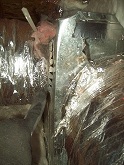 |
| Major supply duck leak | Common supply duct leaks |
The two photographs are of duct leakage. The photo on the left is a flex duct which literally slipped off a plenum. This would never happen if the connection to the plenum was made correctly. The duck leakage in the right hand photograph is more common. The dark area where the round flex duct connects with the sheet metal plenum is also duct leakage. We often find these leaks at every connection in a system. These smaller leaks are the leaks many HVAC companies routinely ignore.
Duct leakage can have a large impact on comfort, efficiency and indoor air quality. A return leak in an attic in Phoenix will suck hot dusty attic air out of the attic and distribute it throughout the house. Return leaks in a crawlspace in a home in Northern Arizona will suck moisture, pesticides and radon out of the crawlspace and deliver it into the house via every supply register. These problems are wide spread.
We suspect many homeowners are not being made aware of duct leakage because it is a convenient issue for most HVAC companies to ignore. Repairing and sealing ductwork is hard work. It is a more profitable business model to simply sell replacement equipment. To combat this indifference in the HVAC community regarding duct sealing and testing the utility companies are offering rebates for duct sealing.
Sealing the ducts is even more important than sealing the building envelope, because, when the air conditioner or furnace is running, the pressures in the air distribution system are much greater than other pressures such as that act on a home wind or stack effect. Pressure differences are what drive infiltration; a hole or crack in the building envelope is not an air leakage point unless it sees a pressure. When the air handler is running, the ducts always operate under pressure, so holes in the ductwork will always leak.
The challenge with duct leaks is that unlike a plumbing or roof leak which you can see, air leaks are invisible, unless you use an infrared camera which can see temperature difference down to a tenth of a degree. In the two photographs below you can actually see the impact of duct leakage. Attic air is being sucked down an interior wall and into the framed cavity return. These are two photographs of the same wall in the house. Notice the return grille on the bottom left photograph. In this house the air distribution system runs 24/7 to filter the indoor air. The return is actually drawing cold air from the attic and these phenomena can be seen in an infrared image. If you look at the infrared image on the right hand side, there is a dark streak going down the interior wall and into the return. Since this photo was taken in the winter, that dark streak is cool air being sucked into the house via the attic.
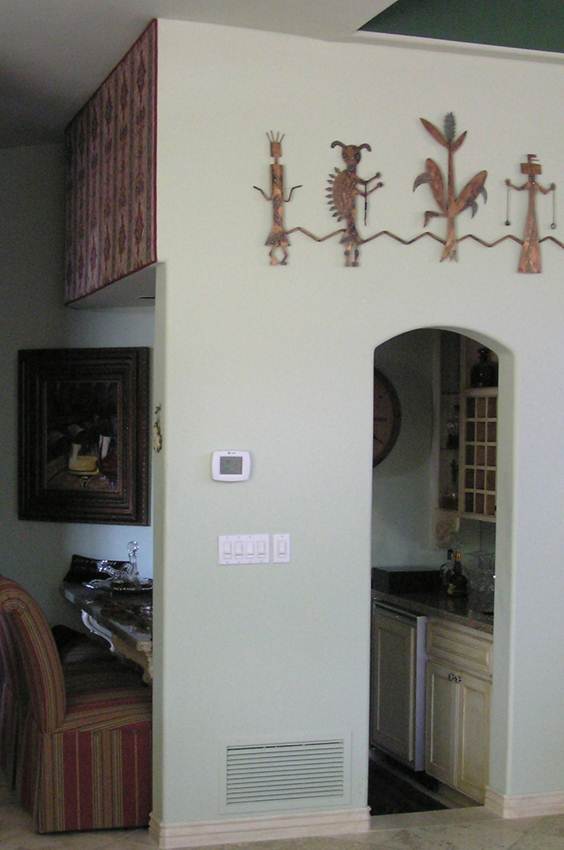 |
 |
| Interior wall with framed return cavity sucked into return. |
Infrared image of cold attic air being |
This homeowner was told to let their air handler run 24/7 so the state-of-the-art filter could clean their air. The cold air and dust being sucked down the interior walls from the attic completely overwhelmed the air filters and exacerbated the dust problem.
The air that leaks from the supply side ductwork is the air you are paying to have conditioned. The air that escapes from supply duct work has been heated to as high as 140°F or cooled to as low as 58°F, and it is not getting to the room it was meant for. If most of the duct work is in either the attic or crawl space (which is typical in Arizona), all this leaking air that has just been through your heat exchanger or cooling coil is now being lost to the outdoors. The resulting energy loss is much greater than the loss that occurs when 70-degree room air leaks out around an electrical penetration.
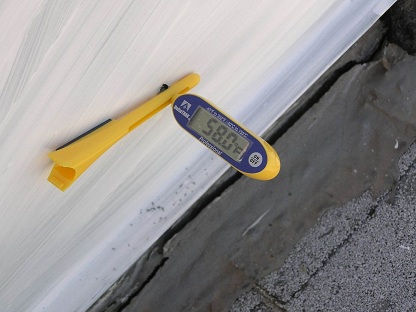 |
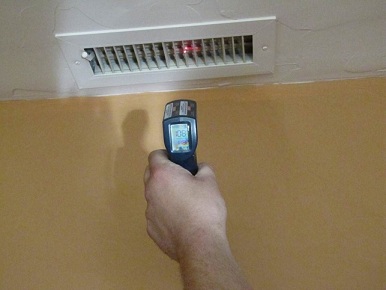 |
| 58°F supply air leaves coil. | 109°F supply air leaving supply register |
Homeowners pay several penalties for duct leakage. The first is higher utility bills. An APS brochure states that, “on average, almost 15% of cooling energy is wasted due to duct leakage. While there will always be some duct leakage, homes with properly sealed ducts can have leakage reduced to 3 to 5%.” The second penalty occurs when you go to sell your home and a home inspector reports that the air distribution system needs to be sealed.
Over the past two decades we have seen a large number of indoor air quality, health and safety problems created by duct leakage. Particulates, dust, allergens, combustion byproducts, pesticides, radon, humidity, etc. are all transported by airflow. Duct leakage and pressure imbalances due to duct leakage and door closure will play a major role in the transport of these indoor pollutants.
Return duct leaks are responsible for many indoor air quality problems. Return ducts draw air back to the unit to be reheated or cooled. The return duct is under a negative pressure because the blower is sucking air back to the unit. Return ducts are often located in attic, garages and crawl spaces. If a return duct leaks it will suck air back from the space it is located. As you observed in the earlier example, the leaky return ductwork was sucking dusty air down an interior wall and distributing the dust throughout the house.
Combustion safety is a major concern. One of our goals is to make sure combustion byproducts, such as sulfur oxides, nitrogen oxides, moisture and possibly carbon monoxide, all flow up the chimney and is vented to the outdoors. Pressure imbalances created by return duct leakage in mechanical closets can reverse the flow of chimneys, thus drawing combustion by products into the home. The photograph on the bottom left shows an auditor with a smoke pencil watching a water heater backdraft due to return duct leakage in a mechanical closet.
 |
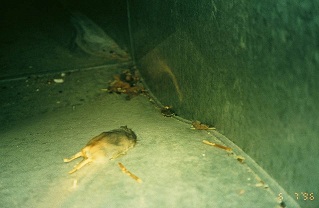 |
| Back drafting water heater – chimney flow is reversed and combustion by-products are entering the house. |
Dead rodent found inside duct system |
The photograph of the dead rodent in the duct system is disgusting and rare, but it is the kind of stuff we occasionally find. Over the years we have found the following in duct systems: rodents, rodent nests, standing water, insects, insulation and construction debris. You can clean a duct system, but if it leaks, critters will find their way back in.
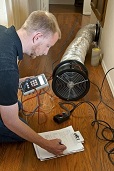 |
| Duct Blaster Test |
There is only one way to make sure that the duct work has been thoroughly sealed and that is to test it. A simple pressure test can measure the airtightness of the air distribution system. The duct blaster provides a direct measurement of total duct leakage. We can compare the duct leakage in your system against national standards. We can also use a blower door and pressure pan to measure duct leakage.
 There is a big difference between sealing ductwork and sealing it correctly. Just because you see mastic being applied to a duct system it does not mean the system is sealed. In the photograph below you can see how a technician sealed the duct with mastic. They left a gaping hole in this return. It is obvious in this photograph that the technician who performed is simply going through the motions. He was probably told to perform duct sealing, but most likely never participated in any meaningful training.
There is a big difference between sealing ductwork and sealing it correctly. Just because you see mastic being applied to a duct system it does not mean the system is sealed. In the photograph below you can see how a technician sealed the duct with mastic. They left a gaping hole in this return. It is obvious in this photograph that the technician who performed is simply going through the motions. He was probably told to perform duct sealing, but most likely never participated in any meaningful training.
At Advantage Home Performance we believe company culture plays a large role in sealing ductwork. If a company only pays lip service to duct sealing you will get an incomplete job. Many HVAC installers do not want to seal duct work after performing a replacement. Sealing ductwork is a step down for them. At Advantage Home Performance we have specially trained weatherization crews for sealing ductwork. These crew weatherization technicians seal duct work while the HVAC technicians are installing the new unit.
Duct sealing should be part of a larger duct retrofit job.Leaky ducts, undersized ducts and restricted ducts should all be repaired at the same time to achieve optimal performance. If ducts are undersized duct sealing can literally solve one problem and potentially create another.
Ideally you do not wait until your AC fails in the middle of summer or winter to get your air ducts sealed. A common scenario we observe is that an old unit fails during extreme weather and the focus is on getting a new unit installed because the house has no air conditioning. For these homeowners it is simply a crisis and having their ducts sealed is almost never a consideration.
Airtight ductwork is one of the keys to a quality heating and cooling system. Compared to a lot of energy conservation improvements, duct sealing is relatively inexpensive. An airtight duct system helps make a home healthier, more comfortable and more energy efficient.
The best way to learn more about your duct system airtightness levels is through your utility company $99 energy audit. These are great programs that not only buy the cost of the energy audit; they also provide generous rebates for repairs.